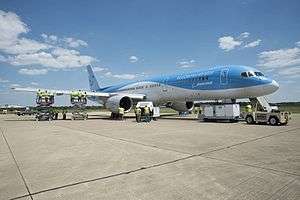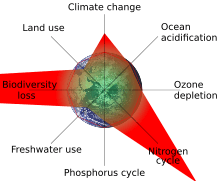ecoDemonstrator
| ecoDemonstrator Program | |
|---|---|
 | |
| 757 aircraft used as testbed in 2015 | |
| Project for | Improved fuel economy and ecological footprint Reduced noise |
| Date initiated | 2011 |
| Predecessor programs | Quiet Technology Demonstrator |
The ecoDemonstrator Program is a flight test research program of aircraft company Boeing, which has used a series of specially modified aircraft to develop and test aviation technologies designed to improve fuel economy and reduce the noise and ecological footprint of airliners. As of December 2015, over fifty technologies had been tested under the program.[1]
History
The ecoDemonstrator Program followed Boeing's Quiet Technology Demonstrator program, which operated between 2001 and 2005 to develop a quieter engine using chevrons on the rear of the nacelle and exhaust nozzles. These chevrons were later adopted on the 747-8 and 787 Dreamliner aircraft.[1]
The ecoDemonstrator Program was formally launched in 2011, in partnership with American Airlines and the FAA. As of December 2015, the ecoDemonstrator program has used three aircraft as testbeds. The first, a 737-800 owned by American Airlines, was used in 2012 to test over 15 technologies. The second aircraft, a company-owned 787-8 Dreamliner, was used to test over 25 technologies. In 2015, a 757 was used to test over 15 technologies, in cooperation with NASA and the TUI Group.
ecoDemonstrator 737 (2012)
Using a Next Generation 737-800, Boeing demonstrated laminar flow technology for winglets, improving fuel efficiency by 1.8 percent. The aircraft tested other technologies, including:[1]
- Active engine vibration control
- Blended biofuel
- Optimized flight trajectories
- Regenerative hydrogen fuel cells
- A variable-area fan nozzle
- Carpeting made from recycled materials
ecoDemonstrator 787 (2014)
Boeing began testing in mid-2014 using a company-owned 787-8 Dreamliner (variable number ZA004, tail number N7874),[2][3] in partnership with the FAA's Continuous Lower Energy, Emissions and Noise (CLEEN) program, NASA's Environmentally Responsible Aviation (ERA) Project, and commercial partners including Japan Airlines, Delta Air Lines, Rolls-Royce, Honeywell, Rockwell Collins, General Electric, and Panasonic. Tested technologies included:[1]
- A ceramic matrix composite engine nozzle, allowing a higher engine temperature
- Fuel containing 15% green diesel and 85% petroleum-derived jet fuel
- Improvements to aerodynamics and flight controls
- Anti-icing wing coatings
- Touchscreen displays in the flight deck
- Carbon fiber outer wing access doors
- Wireless sensors to reduce wiring weight
- NASA's Airborne Spacing for Terminal Arrival Routes (ASTAR) system, intended to allow increased landing frequencies
- Other software and network technologies to optimize flight planning and fuel loading
ecoDemonstrator 757 (2015)
The third aircraft in the ecoDemonstrator Program, a 757-222 (tail number N757ET)[4] owned by Stifel's aircraft finance division, began flights in March 2015. The aircraft was painted in the livery of the TUI Group, which collaborated on the program. Tested technologies included:[1]
- Technologies to improve laminar flow, including a "Krueger shield" to protect the leading edges of the wings from insects
- Active flow control on the vertical tail (tested with NASA under contract for NASA's ERA Project). NASA wind tunnel testing suggest that active flow control could provide a 17% improvement in rudder efficiency, allowing for smaller tails.[5]
- Insect-resistant wing coatings to improve laminar flow (tested with NASA under contract for NASA's ERA Project). For this testing, the aircraft was operated from Shreveport Regional Airport, which was selected for its high insect population, among other factors.[5]
- Solar and thermal energy collecting systems, used to power dimmable cabin windows
Following the test campaign, the aircraft was demolished, and Boeing reported that 90% of its material was reused or recycled.[1][6]
ecoDemonstrator E170 (2016)
The fourth aircraft in the ecoDemonstrator Program, in partnership with Embraer, is an E170.[7][8] Tested technologies will include:
- LIDAR technology to increase air data reliability by complementing current sensors
- An ice phobic paint with low adhesive property, preventing accumulation of dirt and insects, and saving water by reducing aircraft washing
- Special sensors and air visualization techniques to better understand aerodynamics to improve fuel efficiency through new wing designs
- A Brazilian-sourced biofuel blend made up of 10 percent bio-kerosene and 90 percent fossil kerosene
See also
References
- 1 2 3 4 5 6 Kowal, Jessica; Jensen, Bret (December 2015). "Backgrounder: The Boeing ecoDemonstrator Program" (PDF). Boeing. Retrieved 16 June 2016.
- ↑ Uresh, "787 Production and Disposition" (Google Docs spreadsheet), All Things 787, retrieved 16 June 2016
- ↑ "N7874 Boeing Boeing 787-8 Dreamliner - cn 40693 / 4". Planespotters.net. Retrieved 16 June 2016.
- ↑ "N757ET Boeing Boeing 757-222 - cn 24627 / 263". Planespotters.net. Retrieved 16 June 2016.
- 1 2 Barnstorff, Kathy (April 2, 2015). "NASA Tests Green Aviation Technology on Boeing ecoDemonstrator". NASA. Retrieved 16 June 2016.
- ↑ Gates, Dominic (September 2, 2015). "Boeing 757 chewed up, smashed for recycling". The Seattle Times. Retrieved 16 June 2016.
- ↑ "Boeing selects E170 as next ecoDemonstrator". FlightGlobal.com. 7 July 2016. Retrieved 11 July 2016.
- ↑ "Boeing, Embraer Unveil Newest ecoDemonstrator Aircraft". Boeing.com. 7 July 2016. Retrieved 11 July 2016.
